
The accelerator-based pulse neutron source at ORNL’s Spallation Neutron Source operated steadily for users at the maximum design power of 1.4 megawatts on June 26. (Photo credit: Genevieve Martin/ORNL)
The Spallation Neutron Source at Oak Ridge National Laboratory operated steadily at its full design power of 1.4 megawatts for researchers for the first time on June 26.
“We’re producing neutrons now at this intensity for user experiments,” spokesman Bill Cabage said in a telephone interview last week.
The $1.4 billion SNS is a U.S. Department of Energy Office of Science user facility built on a ridge top at ORNL. It uses a linear proton accelerator and mercury target to provide the most intense pulsed neutron beams in the world for scientific research and industrial development. The proton beam hits the mercury target, knocking off neutrons from liquid mercury atoms. The neutrons, which are used to study materials from superconductors to biological systems, are then channeled down 16 instrument beam lines, where neutron spectrometers produce data revealing the structures and dynamics of molecules and atoms.
The SNS has been used for experiments since it started producing neutrons in April 2006, but at lower power. Researchers wanted to eventually get to full power, even if that had to be done gradually during the past eight years.
“They didn’t want to have a lot of disruption playing with it,” Cabage said. “They wanted to keep it reliable for users.”
At the same time, though, “The more power, the more you can do,” Cabage said.

A mercury target at the Spallation Neutron Source is pictured in the target bay area during a 2009 changeout. (Photo courtesy of ORNL)
Kevin Jones, director of ORNL’s Research Accelerators Division, said the lab has implemented technical and operational improvements to allow stable operation at 1.4 megawatts with little operating margin.
“Running the accelerator at this power level is challenging,” Jones said in a story about the recording-breaking month at SNS posted on ORNL.gov. “We have a great deal of work remaining over the next few years to add operating margin and to assure ongoing highly reliable operations.”
Operating at 1.4 megawatts makes a big difference to users and research teams, said Paul Langan, head of the Biological and Soft Matter Division and director of the Center for Structural and Molecular Biology at ORNL.
“The higher power provides more neutron flux that allows us to extend our reach and broaden our impact in the fields of soft matter and biological research by enabling measurements with smaller samples that are impossible at a lower power,” Langan said. “For example we can look at thinner polymer films and smaller crystals of large medically important complexes.”
Cabage said the SNS was “revved up” to 1.4 megawatts in September, right before a maintenance outage and target change. But this time, the SNS ran at design power for experiments, he said.
Now, it’s down again for a periodic target change and scheduled maintenance outage.
ORNL said the SNS target, the facility’s ninth, was the highest-dose target as of June 23, when it had 4,057 megawatt-hours. That’s 300 more than any previous target. That target, Target 9, was also operating during the record-breaking 24-hour, 1.4 megawatt run at SNS.
“Target 9 powered more science with greater intensity than any other SNS target—truly a target lifetime achievement award,” the ORNL story said.
The lab said the SNS targets are a one-of-a-kind design that take a year to manufacture, and they must be precisely installed. The targets are routinely replaced because of deterioration from the impacts of the high energy proton beam.
“The extreme care needed to ensure safety makes the replacement process both slow and tedious,” the story said. “Given these challenges, it is desirable for targets to be as long-lasting as possible.”
A new target, called a jet-flow target, has been designed to provide even more reliable operations at SNS. The first jet-flow target was received on May 21 at SNS, and will be installed during the summer shutdown in July. Jet-flow targets add a fast flow of mercury to the inner window that is intended to reduce mercury cavitation damage, ORNL said.
Leave a Reply